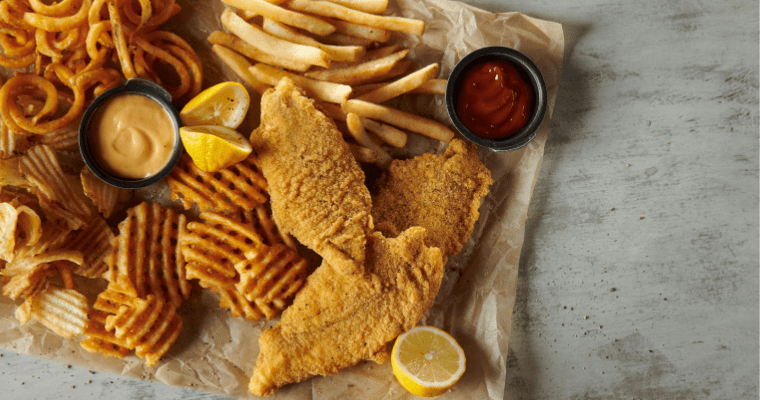Oil is one of the most important ingredients in your crispy menu options – it affects the flavor profile and presentation of food. That’s why it is imperative that you choose the right one to fit your business.
When choosing a frying oil, there are a few questions you need to ask:
- Oil & Oil Blends: What blends are available to achieve the most preferable characteristics such as mild flavors, longer oil life, and extended crispiness after leaving the fryer?
- Relative Fry Life/Oil Breakdown Time: All oils break down. How long before oil breakdown begins? Once it starts, how quickly will I need to replace it?
- Flavor Profile: What does the oil taste like, and how does that affect the taste of my food?
- Cost: How much is it going to cost me to use different kinds of oil in my fryer?
Oil, Oil Blends, and Flavor Profiles
Frying food with different types of oils has different effects on your food. Common types of oil include Corn, Canola, Peanut, Soy, and Sunflower, and each oil has its own list of benefits. It is important to consider the flavor of the oil you are using when deciding which kind of fry oil to use for various crispy foods.
Oils that are considered “premium” typically have benefits such as longer fry life, less absorption, or lower monounsaturated fats. Oil blends, such as cottonseed and soy, can be used to combine the most preferable characteristics as well.
Fry Life and Oil Breakdown
One of the most important things to consider when choosing an oil is how often you need to change it – but keep in mind that how you use and take care of your fry oil can affect its fry life too. Even though premium oils are highly stable, there are factors that will contribute to a shortened life. We like to use the acronym HAMSS to remember some of these factors:
- Heat – monitor the heat level in your fryer. Heat is needed to cook, but if it’s too hot, your oils will break down too quickly.
- Air – cover your fryers during slow hours and at night to reduce its contact with air.
- Moisture – everything you cook contains moisture – particularly proteins like chicken. Load your fry baskets away from the fryer especially when food is frozen.
- Salt – salt breaks down in oil and can cause foaming. Drain brined items well before frying, and add salt after frying instead of before.
- Soap – use only cleaning agents that your fryer manufacturer recommends. Soaps and detergents break down oil.
Other things that can affect oil life include carbon buildup, which looks like cakey black grease spots in your fryer, and poor oil maintenance. Filtering your oil regularly and using a skimmer to capture stray particles helps prevent both carbon build-up and flavor transfer.
| Oil Type | Flavor Profile | Relative Fry Life |
| Soybean Oil | Bland/Buttery | ⬤ |
| Canola Oil | Neutral | ⬤ |
| Corn Oil | Sweet | ⬤◖ |
| Gordon Signature Creamy Soy/Cottonseed Blend | Slightly Buttery | ⬤⬤ |
| Cottonseed Oil | Neutral | ⬤⬤⬤ |
| Peanut Oil | Nutty | ⬤⬤⬤◖ |
| Lard Cube | Neutral | ⬤⬤⬤◖ |
| Gordon Signature Simpli-Fry Clean Frying Oil | Neutral & Sweet | ⬤⬤⬤⬤ |
| Gordon Signature High Oleic Canola Oil | Neutral | ⬤⬤⬤⬤◖ |
| Gordon Signature SunFry Sunflower Oil | Neutral/Mild Nutty | ⬤⬤⬤⬤⬤ |
| Tallow Cube | Beefy | ⬤⬤⬤⬤⬤ |
When Your Frying Oil Isn’t Saving You Money
An important thing to consider when choosing what oil to use, beyond flavor and fry life, is how much money it costs you over time. Sure, lower-quality oil will cost less initially – but over time, are you spending more on oil as a result? Use the calculator below to compare cost savings between the oil you’re currently using to the premium oil you’re considering.
So, What Oil Should You Choose?
The decision can be tricky – when each oil has its own benefits, it’s worth it to evaluate which one works best for your business.
Ultimately, quality, profit, and value are present if you choose a premium oil to fill your fryer with. Using premium oils results in better-looking & tasting food and better consistency between batches. It also means fewer oil changes, which in turn provides reduced labor needs and fewer safety issues handling hot oil. Additionally, you will see reduced costs for discard and disposal, because less waste is being created. If you have a take-out business, using premium oil can keep your food crispier for longer after it has left the fryer, creating a more satisfying meal for customers who aren’t eating the food right away.
All of these factors affect your bottom line: by switching to premium oil, you’re creating satisfied customers, getting more repeat business, and increasing your profit.
Below, we’ve listed our four most popular premium oils and their characteristics in order to help make that decision a little easier.
| Gordon Signature Premium Soy Blend Liquid Fry Shortening (Cottonseed/Soy Blend) | Gordon Signature Simpli-Fry Clear Frying Oil | Gordon Signature High-Oleic Canola Oil | Gordon Signature SunFry Sunflower Oil |
| – Clear & creamy option – Provides longer fry life than soy – Greater crunchiness for mouthfeel – More economical option than pure cottonseed oil | – Proprietary blend of frying oil designed to simplify oil procurement – Provides protection from flavor transfer – Maximizes fry life – Provides a slightly sweet flavor – Provides golden color | – Lowest in saturated fat – Clean flavor that lets the food’s flavor shine – Higher stability oil with greater heat tolerance and longer shelf life | – 0g Trans Fat per serving – Superior fry life – Clean flavor that lets the food’s flavor shine – Non-GMO |




























